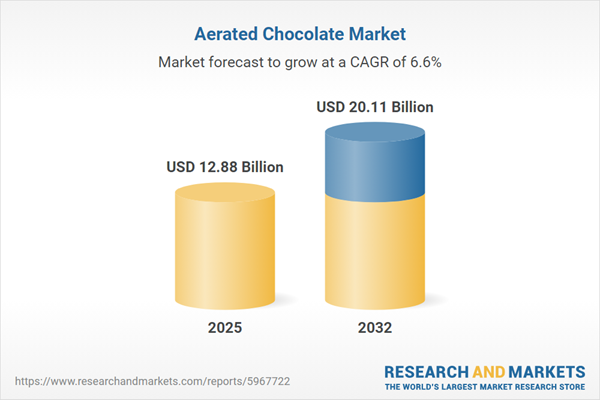Speak directly to the analyst to clarify any post sales queries you may have.
The aerated chocolate market is evolving as manufacturers leverage innovation and enhanced consumer insights to refine product portfolios and optimize value. In this environment, senior decision-makers face both new challenges and opportunities as they guide strategy amid shifting demands and advancing production technologies.
Market Snapshot: Aerated Chocolate Market Size and Growth
The global aerated chocolate market is valued at USD 12.07 billion and is projected to rise to USD 12.88 billion within the next year, supported by a compound annual growth rate of 6.58%. This growth is driven by strong interest in novel chocolate textures, expanding taste varieties, and increased accessibility through digital and traditional retail platforms. Brands—both multinational leaders and emerging competitors—actively invest in omnichannel strategies and advanced analytics, with a focus on capturing higher-value consumers across diversified sales channels.
Scope & Segmentation: Strategic Insights for Market Positioning
This report equips senior leaders with actionable intelligence, enabling focused resource deployment and market prioritization in the competitive aerated chocolate sector. Executives can leverage detailed segmentation to understand critical growth factors and shifting consumer preferences, forming the basis for data-driven expansion and brand leadership strategies. Key segmentation areas include:
- Product Types: Develop offerings in dark, milk, and white chocolates to match broad consumer palates and accommodate preferences for varied cocoa contents.
- Distribution Channels: Enhance reach and engagement through supermarkets, e-commerce, convenience shops, specialty retailers, and conventional outlets, ensuring effective access to priority segments.
- Product Formats: Capture diverse occasions—ranging from everyday snacking to gifting—by including mini bars, standard slabs, multi-packs, baking drops, seasonal figures, chocolate cups, and snacking pellets in product assortments.
- Flavors: Create differentiation by delivering fruit-infused, nut-based, and classic unflavored variants tailored to regional and demographic preferences.
- Aeration Levels: Employ macrocellular and microcellular aeration techniques to craft distinct texture experiences and foster brand loyalty.
- Regions: Shape strategy for the Americas, Europe, Middle East & Africa, and Asia-Pacific—considering factors from regulatory standards to consumer habits and emerging ingredient trends in each area.
- Leading Companies: Draw on insights from market influencers, including Nestlé S.A., Mars, Mondelēz International, Ferrero, Hershey, Lindt & Sprüngli, Barry Callebaut, Meiji Holdings, Lotte, and Pladis Global, all of whom set competitive trends through scale and innovation.
Key Takeaways: Actionable Insights for Senior Leaders
- Innovative aeration processes are transforming chocolate texture, supporting differentiation and improving consumer experience.
- Automation in foaming and aeration enhances production agility, facilitating swift adaptation to shifting preferences and streamlined supply chain operations.
- Brands offering products with natural ingredients or reduced sugar attract health-conscious consumers and encourage trust among new customer segments demanding ingredient transparency.
- Diversifying sourcing partners and employing adaptive supply strategies protects companies from supply chain disruptions, safeguarding consistency across diversified markets.
- Integrating digital with physical retail channels extends customer reach and fosters enduring brand engagement, fortifying multi-channel go-to-market approaches.
- Collaboration with suppliers and technology partners accelerates the pace of product innovation and enables prompt alignment with evolving market and regulatory trends.
Tariff Impact: Navigating Recent United States Policy
Current tariff changes in the United States prompt aerated chocolate manufacturers to re-evaluate supply chain infrastructure, especially in cocoa sourcing and equipment acquisition. Proactive measures such as supplier diversification, local manufacturing investments, and dual sourcing strategies support cost management and operational reliability in response to evolving regulations.
Methodology & Data Sources
This market assessment synthesizes executive interviews, consumer trend studies, and proprietary data analytics. Conclusions are further validated through subject matter expertise in confectionery technology and global logistics, ensuring senior leaders access well-rounded and accurate perspectives.
Why This Report Matters
- Empowers senior leadership to anticipate and respond to changing market dynamics, tracking technological advances alongside evolving consumer trends.
- Enables timely and effective execution in market entry, partnership selection, and resource distribution through targeted segmentation and actionable analytics spanning all major regions and product categories.
- Supports continuous improvement in procurement, logistics, and overall supply management as industry standards and global regulations shift.
Conclusion
Data-driven strategies and agile leadership are essential to thrive in the complex aerated chocolate market. This report offers focused guidance to support competitive positioning and enduring business growth.
Additional Product Information:
- Purchase of this report includes 1 year online access with quarterly updates.
- This report can be updated on request. Please contact our Customer Experience team using the Ask a Question widget on our website.
Table of Contents
3. Executive Summary
4. Market Overview
7. Cumulative Impact of Artificial Intelligence 2025
Companies Mentioned
The companies profiled in this Aerated Chocolate market report include:- Nestlé S.A.
- Mars, Incorporated
- Mondelēz International, Inc.
- Ferrero International S.A.
- The Hershey Company
- Lindt & Sprüngli AG
- Barry Callebaut AG
- Meiji Holdings Co., Ltd.
- Lotte Co., Ltd.
- Pladis Global
Table Information
| Report Attribute | Details |
|---|---|
| No. of Pages | 181 |
| Published | October 2025 |
| Forecast Period | 2025 - 2032 |
| Estimated Market Value ( USD | $ 12.88 Billion |
| Forecasted Market Value ( USD | $ 20.11 Billion |
| Compound Annual Growth Rate | 6.5% |
| Regions Covered | Global |
| No. of Companies Mentioned | 11 |









